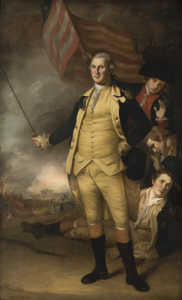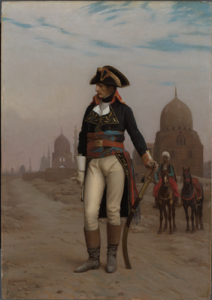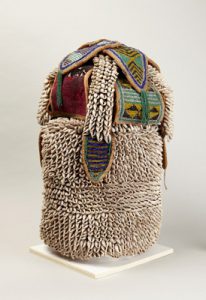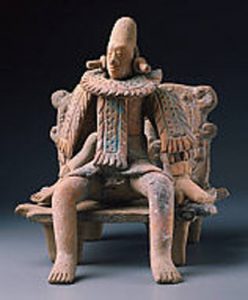Discussion goals: By placing each work in a historical context, and by considering its technique and materials, students will be encouraged to analyze the significance of the depicted figures’ poses and scale, relationships between specific materials and hierarchy, and the effects of colonization and nationalism on representation.
Charles Willson Peale, George Washington at the Battle of Princeton

George Washington at the Battle of Princeton
1783–84
Oil on canvas
237 x 145 cm. (93 5/16 x 57 1/16 in.)
frame: 275 × 179 × 10 cm (108 1/4 × 70 1/2 × 3 15/16 in.)
Princeton University, commissioned by the Trustees.
PP222
George Washington at the Battle of Princeton, as its title implies, evokes the battle itself (one that Peale had experienced firsthand as an officer of the Philadelphia militia) and makes specific reference to events from it, notably the death of Washington’s friend General Hugh Mercer, shown expiring in the arms of surgeon Benjamin Rush, a blood-stained bayonet lying at the general’s feet indicating the cause of death. With sword poised in readiness, Washington gestures to the battle raging behind him, where Continental troops, pistols and muskets blazing, force the British soldiers away from their Nassau Hall stronghold–or, in the pictorial logic of the painting, literally out of existence, off the picture plane, in the direction that Washington’s raised weapon appears to impel them. Meanwhile, a diminutive horseman bearing a white flag, just visibly rendered approaching from Nassau Hall, makes apparent that Mercer’s ultimate sacrifice, and by implication that of others in the patriot cause, had not been in vain, as American forces would soon carry the day and thereby gain invaluable confidence in their larger campaign against a formidable adversary.
Conversation prompts:
There are several parts to this composition. What would you say is the focus of the painting, and why?
How are the three figures to the right of Washington depicted? How do they connect with one another?
Peale represented several geographically and temporally distinct events in one painting—what stylistic choices did he use to unify the composition?
Jean-Léon Gérôme, Napoleon in Egypt

Napoleon in Egypt
1867–68
Oil on wood panel
35.8 x 25.0 cm (14 1/8 x 9 13/16 in.)
frame: 48.3 x 38.4 x 4.1 cm (19 x 15 1/8 x 1 5/8 in.)
Museum purchase, John Maclean Magie, Class of 1892, and Gertrude Magie Fund
y1953-78
During the Second Empire (1852–70), Napoleon III encouraged the cult of his uncle, Napoleon Bonaparte, whose 1798 Egyptian expedition is illustrated here. Gérôme shows the legendary general before the Mamluk Tombs outside Cairo. Born slaves, these rulers owed their rise to military prowess and would have been a subject for reflection by Napoleon as he surveyed the city below. Gérôme’s Near Eastern scenes, based on his travels to Constantinople, Egypt, and elsewhere, rival photography in their meticulously rendered details.
Conversation prompts:
Describe Napoleon’s pose and costume and the effect they have on the viewer.
How did Napoleon relate to the figures and the architecture in the background?
Yorùbá artist, “House of the Head” shine (Ilé-Orí)

Nigeria
“House of the Head” shine (Ilé-Orí)
20th century
Cowrie shells, glass beads, cotton, and velvet
h. 49.8 cm., diam. 28.0 cm. (19 5/8 x 11 in.)
Bequest of John B. Elliott, Class of 1951
1998-736
As the slave trade devastated Yoruba communities, the need for self-protection generated new practices focused on the individual. These included keeping a “house of the head” (ile ori) like this one, which encased a shrine (ibori) dedicated to the inner, spiritual component of the head. Cowrie shells like those that encrust this structure were traded as currency in exchange for human life during the height of the Atlantic slave trade; thus, the cowries brought to the Nigerian coast on Portuguese ships represented the violence and the wealth of the Atlantic economy. A cowrie-covered ile ori protected the individual spiritually and also literally, through the accumulation of trade wealth. Upon their owners’ deaths, ile ori were traditionally dismantled, their cowries redistributed among relatives and returned to circulation. In the case of this intact example, the owner probably converted to another religion before his death.
Conversation prompts:
Describe the different ways that the cowrie shells are functioning on this object—as material elements (with architectural and textural effects) and/or as symbols of power.
European glass beads also functioned as currency within the transatlantic slave trade. How did this asymmetrical system of power and wealth affect the ways in which we can appreciate the fine beadwork on this object?
Maya Enthroned Lord

Maya
Jaina Island or vicinity, Northern lowlands, Maya area, Campeche, Mexico
Enthroned lord
A.D. 600–800
Ceramic with polychrome pigment
figure: h. 16.8 cm. (6 5/8 in.)
throne: h. 10.6 cm. (4 3/16 in.)
overall: h. 15.1 cm., w. 12.7 cm., d. 12.7 cm. (5 15/16 x 5 x 5 in.)
Gift of Gillett G. Griffin
y1986-87 a-b
This figure’s elongated forehead likely was once covered by a large headdress, which is now lost. This cranial form only slightly exaggerates the intentional shaping of the heads of noble infants for aesthetic reasons. The collar and flaps worn around the neck and shoulders may represent a form of armor—made of unspun cotton, a material well suited to deflecting hurled spears—suggesting that this king was also a warrior. On the throne’s backrest appears an attendant dwarf in cut out and silhouetted low relief, surrounded by billowing swirls of smoke or vegetation. The seat of the throne is covered with a jaguar pelt, whose head and feet jut out at the sides.
Conversation prompts
Describe the appearance of the figure. Which attributes seem to be associated with the political power of this Maya king?
Does the throne include details that might signal the authority of the person who sits upon it? How? Would the throne convey similar meaning when the king was absent?
Sample classes and checklists
Peter Field (POL 322): American Statesmanship and Symbolism
Murielle Perrier, FRE 359: Power, Passion, Ideology
Bryan Just, ART 468/LAS 468: The Art and Politics of Ancient Maya Courts

